(self) Dove: aa Ccʰ D* E* pp Uw*
Dove is one of the rarer coat colors of the Mongolian gerbil. This color is created when a Black gerbil carrying a Himalayan colorpoint gene inherits the Pink Eye gene – and is where the whole coat is pale silver, including the tummy.
[So rare – I am still awaiting an image]
This color is one of three shades of silver-colored gerbils found – using the two most common gerbil colour genes – the Agouti gene and Pink Eye gene (see text below). However, due to most gerbil lines not obviously carrying the Himalayan colorpoint gene, this is the least seen of the three silver shades found in pet gerbils.
Dove is the palest of the three shades and is quite a unique colour.
Like the other silvers , they are the same delicate colour all over including tummy, ears and tail. Lilac is the darkest of the three shades (as it has no colorpoint dilution – top image below) followed by Sapphire (a bit lighter than Lilac – bottom image below) but not as light as Dove.
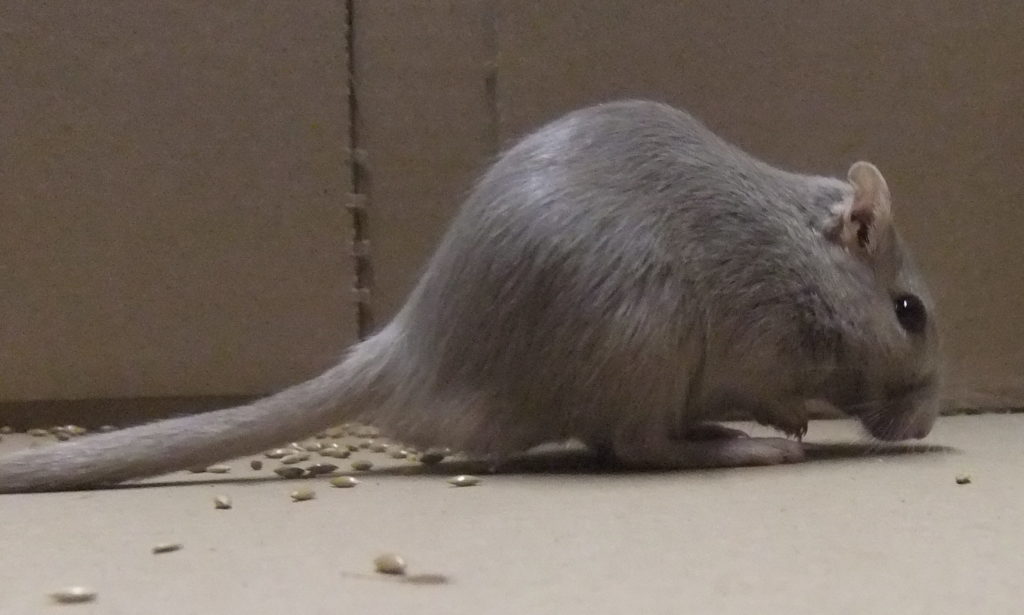 Doves are easy to identify 90% of the time – as they are the only solid grey gerbil color – but with the new dilution gene (D) and mottling with different combinations of the three spotting genes out there, it is possible to get them confused at first glance with lighter Sapphires and some of the new Blue colours.
Doves are easy to identify 90% of the time – as they are the only solid grey gerbil color – but with the new dilution gene (D) and mottling with different combinations of the three spotting genes out there, it is possible to get them confused at first glance with lighter Sapphires and some of the new Blue colours.
But a non-spotted Dove is easy.
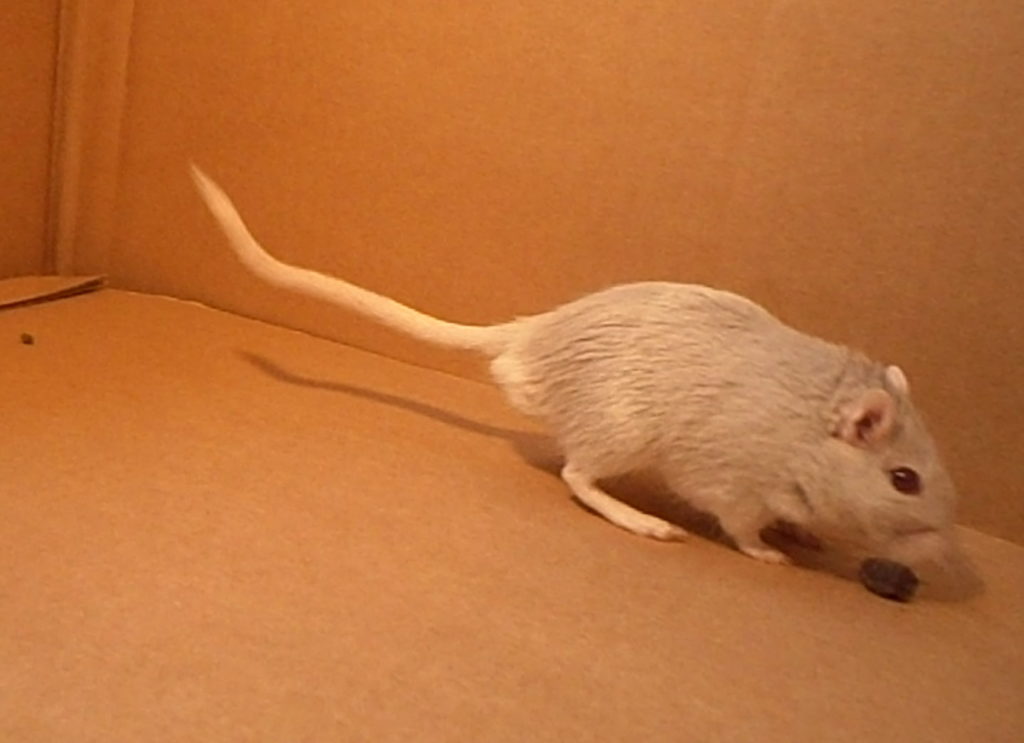
In the gerbil fancy – there is often a Dove class – but it won’t just have genetically Dove gerbil in it. Gerbils entering this class only have to fit the physical description given – they can however have ANY genes they want in there. Don’t be tricked if you are after the right thing.
Dove is the exact genetic [aa] pair to an Argente Cream – another unusual color – which has the same color and genetic notation – [cʰcʰpp].
Lilac is the equivalent of the Argente Golden and Sapphire are the self-version of Argente Fawns.
Pink Eyes in the population:
The gene that creates the silver colour – the Pink-Eyed gene – works by diluting all the pigment forming cells in a growing embryo – this results in the black being lost from the eyes (leaving them pink) and in this case it has the effect of removing all the black from the hairs too leaving the gerbils silver – basically a Dove gerbil is a Black gerbil with none of its black pigment.
This gene has the same effect on Agouti to create the Argente – it strips out the black from the eyes making them pink and it strips out the black from the tip of the coat leaving only the gingery color underneath (it doesn’t affect the silver undercoat which you can still see on an Argente by parting the fur). Just as an aside – Argente actually means silver?
The actions of this gene are also associated with poor vision and damage to the eyes as these gerbils now have no protection from the sun and you can see straight into the blood vessels and tissues – hence the pink colour.
The black pigment in the iris – found in most gerbils – generally blocks out the harmful effects of the sun. However, it just isn’t there in gerbils with pink, ruby and red eyes. As a result, over time the effects of sunlight will damage some of the delicate tissues in the eyes which are now unprotected.
I’m not sure if it IS Dove yet?
Well, as described above, you will most likely know for sure just by looking that you have a Dove – although if it is quite dark you could assume that a Sapphire is what you actually have (image below).
Either way – unless you are breeding it doesn’t matter really – so I would call it a Dove as it is quite an unusual colour in the gerbil fancy!
Mottled or pied versions of any of the following colors might look like a Dove at first – Light Grey Agoutis, CP Grey Agoutis, LCP Grey Agoutis (image below right), CP Golden Agoutis, LCP Golden Agoutis, Light Polar Foxes, CP Polar Foxes, LCP Polar Foxes can all be very light grey or have a grey tinge to them – but once you drill down through their white tummies (Dove doesn’t have a white tummy) and ticking (Dove doesn’t have any ticking) – you can rule them all out.
You can’t use a Dove’s pale toenails on these – as ALL gerbils carrying the Dominant Spotting gene have white toenails! Great.
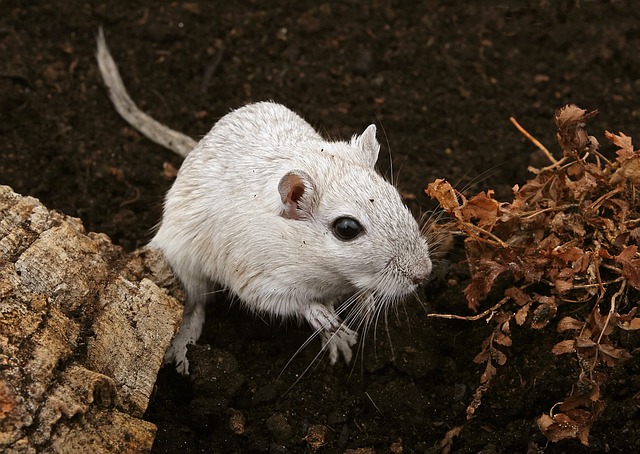
If you are still doubting your own eyes – rub their hair on your gerbil the wrong way, as a Dove coat will be silver from top to bottom – all the same. However, all the gerbils listed above are on the agouti-based side of things so will all have different color hair underneath that ticking.
There are still Light, CP and LCP Silver Nutmegs to contend with – who are also greyish – and don’t have a white tummy – but you can clearly see the smooth ‘full’ color of the Dove (and other silvers) when you part the hair. It is quite unmistakable.
You have Dove gerbils you want to Breed?
Due to the prevalence of all the common genes needed to create a Dove gerbil, you only need to add in the more unusual Himalayan gene for sure to start creating Doves.
Genetics-wise (apart from the cʰ) the genes for a Dove gerbil are quite ‘strong’ (strong in this instance means prevalent and dominant), so mating a Dove gerbil to any other pink-eyed gerbil on the self side, you will probably get Dove pups in the mix. You don’t usually get a Dove in a litter from any-old gerbil – but it isn’t impossible.
You want Dove Pups?
There are only a few ways to get Dove pups in your litters because of this pesky [cʰ] gene playing hard to find.
If you want 100% Dove pups in your Dove litters – you are out of luck. Doves do not breed true as they need two different c genes at their colorpoint locus. Because they need both [C] and [cʰ] at the same time – when you breed them together they will never give their pups these exact long-searched for genes – they will mix them up.
As a result, breeding together two Dove gerbils will give you the following 3 pup colors:
- 50% – Dove
- 25% – Lilac
- 25% – Pink-Eyed White*
*These darn Pink-Eyed Whites (PEWs), get everywhere – and usually they are a bit of a pain for a breeding program as you can’t tell what they actually are genetically – however, in the above example you do know what they are – they are Dove carrying-machines! Great work…
If you were to create one of these PEWs – you could use it in your line paired, ideally, to a Lilac you would create as near as 100% Doves as anyone could (all bar the odd recessive).
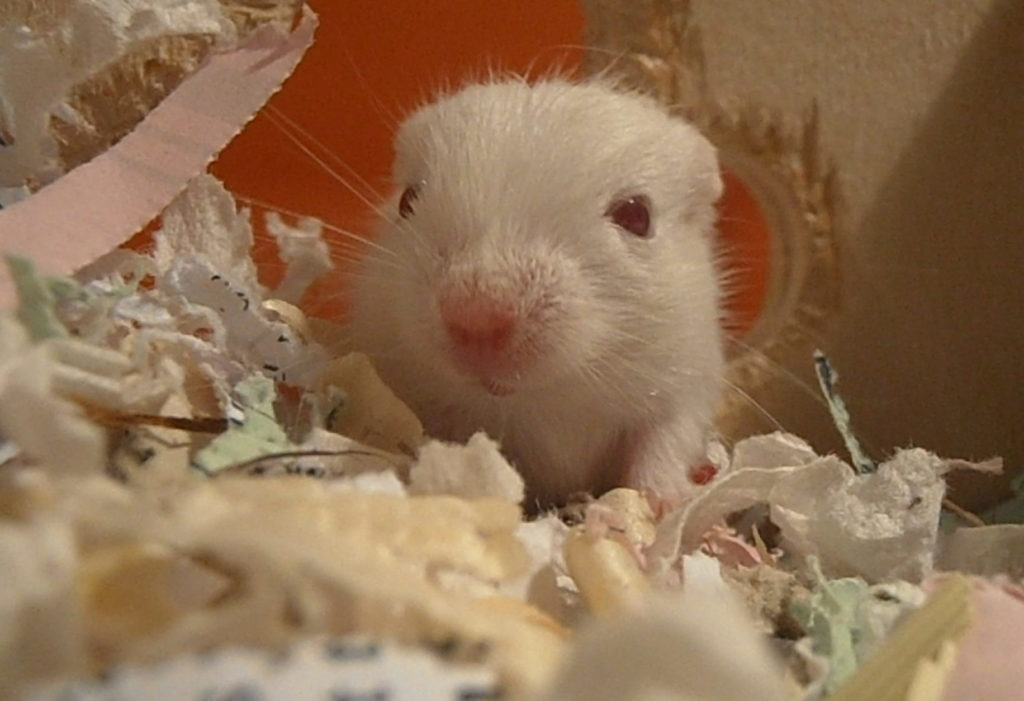
However, to get a large percentage of them in your litter without this inside information you would best do one or all of the following things:
Only breed gerbils on the self side
Basically do not breed any Agouti-based colours or any double-sided colours (colours that could actually be either A* or aa but you can’t tell by just looking) – avoid for example PEW, Himalayan or BEW (unless you definitely know their parentage).
By eliminating the dominant Agouti gene [A] you are instantly doubling your chances of getting Doves.
Only breed gerbils with red/pink eyes
Basically breeding only pink-eyed gerbils means you will be eliminating all the dark-eyed colors (Slate, Black etc) – which effectively doubles the chances of you getting Dove pups instantly – breeding a Dove to any Argente gerbil would be perfect percentage-wise.
However, be careful not to use two red-eyed gerbils with the same sets of additional recessives – as otherwise you will only get pups with those (i.e. don’t breed two Apricots, or an Apricot to a RESN as all the pups will be pink-eyed [uwᵈuwᵈ] gerbils = no Doves can be made here).
Always breed only one self colorpoint in a pair
If you use two colorpoints you won’t get Doves – as you need one non-colorpoint [C] in there, However, using no colorpoint colours will reduce you chances of getting Doves – possibly to zero.
Ideally you would use any light colorpoint colors for this – but they are hard to spot unless they are a Siamese or LCP Slate – so you may have to gamble on a light-looking ordinary dark-eyed colorpoint and hope for the best. Doing this though, you will need to balance out the red eyes – so ideally a Siamese to a pink-eyed self would be good.
You could gamble on a PEWs though – as they are also colorpoints and have the pink-eyed gene – but you really would need some idea that they had a [cʰ] parent at least and that they weren’t [AA] or [cᶜʰᵐcᶜʰᵐ] – as these would stop your breeding plan dead and take generations to eliminate again. Grr…
Some people like to breed all the silvers together so mixing up your [C] locus genes can be fun through the generations. You can get all three in the same litter with a 25% chance of each (using a Sapphire and a Dove as parents) but you will also get 25% PEWs in the mix.
Don’t have Dove gerbils – but want them?
If you don’t have any Dove gerbils of your own but still want them – you could try one of the following plans to get them…
1) Breed any red-eyed self-based gerbil with an Argente Cream* ( – could be good)
2) Breed any red-eyed self-based gerbil with a Siamese gerbil** ( – could be good)
3) Breed a really light colorpoint to a Burmese or CP Slate gerbil ( – for a first generation***)
*The Argente Cream would need to carry a recessive [a] to make this work
**The Siamese would need to carry the recessive [p] to make this work
***If you can pull out a hidden [cʰ] from an unidentifiable LCP something-or-other and add it to a known [cᶜʰᵐcᶜʰᵐ] self colorpoint in a pairing – it will throw out Siamese or LCP pups – both of which are easily identifiable (see Siamese in below image) and which can be used in your Dove program.
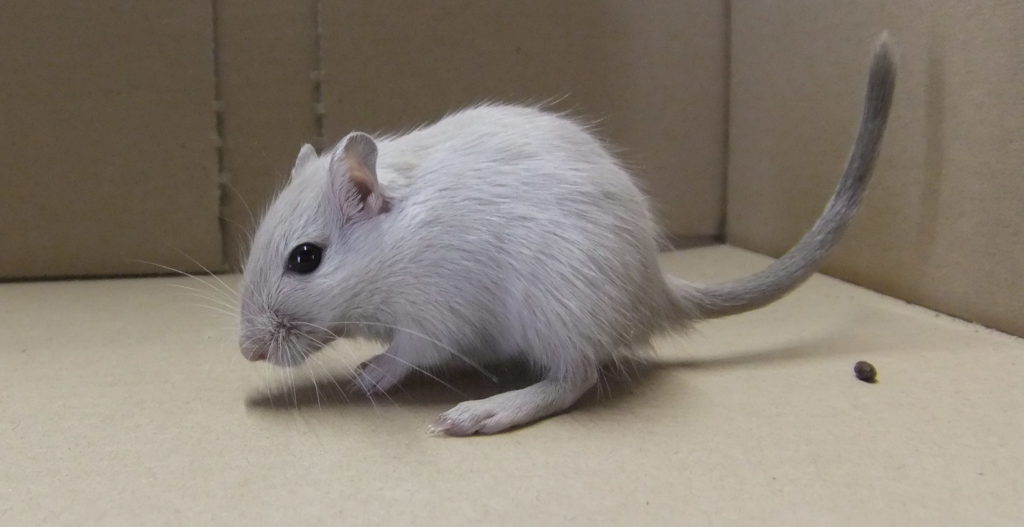
Either way, after the first round of breeding, you would have all the right genes at your disposal – you would just need to make sure you kept your records in order.
Then you could start a Dove Deluge.
Don’t want Dove pups in your litters?
There are several ways you can be sure of NOT getting Dove pups in your litter, but seeing as they are quite rare anyway in litters – you might get away with just reducing the percentage of chance to almost zero with each breeding pair.
For example, if you have the genes to make 10 colours of pup – one being Dove – the chances of it coming up in one litter is slim anyway (it will be much less than 1 in 10 as there are so many more ways to make Black). So rather than eliminating Dove genes – you could flood the gene pool with other genes. Neat trick.
Don’t breed gerbils with pink/ruby/red eyes
If neither parent has the pink eye gene in a double dose – you won’t get first round Doves – and if you do – it will only be a 25% chance or less of being Dove to boot. To delete all Doves completely – you would need to make sure one or both parents were double dominant for the [P] gene – so [PP] (which may need test breeding to determine).
However, if you only have one parent who is [PP] – there is a chance down the line – even if you only breed dark-eyed gerbils together that a pink-eyed pups could turn up at some point – and it could be Dove no matter how rare they are.
Use gerbils that carry loads of other recessives
By breeding for rainbow litters (making sure both parents are heterozygous at every loci: Aa Cc Dd Ee Pp etc, you can decrease your chances of one of the pups being Dove. If you can remove the recessive colorpoint genes at the same time – you are doing just fine.
Only breeding Burmese (and other cᶜʰᵐcᶜʰᵐ colourpoints and carriers)
A Dove can’t be created with the [cᶜʰᵐ] gene – it needs only the [C] and [cʰ] genes – so by breeding only those with the unwanted colorpoint gene of [cᶜʰᵐ] – you will eliminate the Doves.
Using any of the techniques above will obviously reduce the amount of other gerbil colors you could get in your litters to due to this narrowing of genes; so do have good record keeping to help you stay on top of who’s who.
Test breeding and planning your line are very important to accomplish this.
For more information about Breeding for Color please do read on…